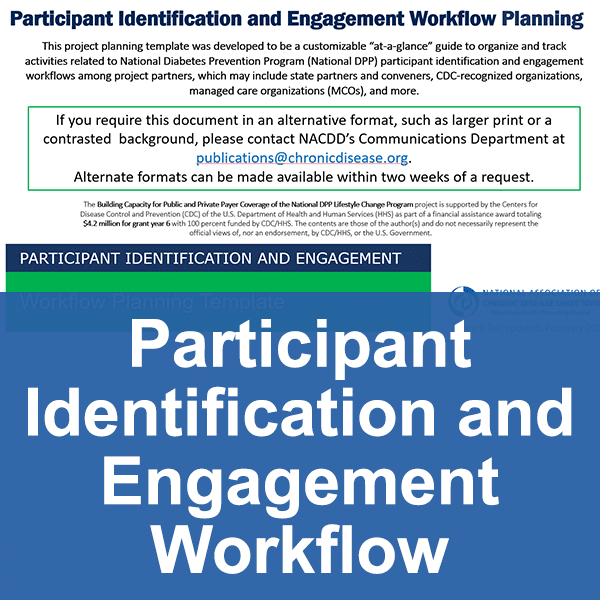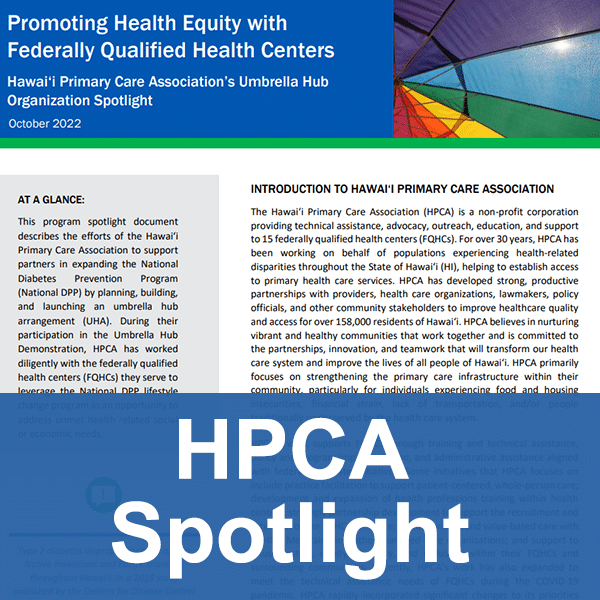Health Equity → Health Equity and the National DPP → Leveraging State and National Health Equity Initiatives
Leveraging State and National Health Equity Initiatives
While the National Diabetes Prevention Program (National DPP) lifestyle change program can focus on skills that help to address health-related social needs (HRSN), the program can also be connected to larger initiatives that are centered on health equity. It can work in tandem with larger state or national goals and initiatives related to addressing health equity, such as reducing the rates of chronic disease in populations of focus, addressing disparities in accessing preventive services, or working to increase access to healthy foods across populations.
State Medicaid agencies, public health, managed care organizations (MCOs), and CDC-recognized organizations are aware of initiatives across the state and in specific communities that address HRSN and could consider initiating partnerships that increase participants’ access to these services. For example, many states and communities have programs related to healthy food procurement. Strategies to improve access to healthy food among people with higher risk for chronic disease include efforts such as implementing healthy food prescription programs at farmers’ markets; stocking healthy foods at certain grocery stores, gas stations, and corner stores; and issuing permits for mobile produce vendors. These types of initiatives may offer opportunities for CDC-recognized organizations to support Medicaid beneficiaries in accessing healthy foods to support the lifestyle changes they are learning about in the program.
This page will describe opportunities to connect the National DPP lifestyle change program to state or national initiatives, and is divided into the following two sections:
- Addressing HRSN Through Cross-Sector Partnerships
- HRSN Screening Tools
- Examples of National and State Health Equity Initiatives
Addressing HRSN Through Cross-Sector Partnerships
Coordinating and collaborating with partners across sectors, including state Medicaid agencies, Medicaid MCOs, health care providers, and community partners can improve efficiencies in addressing HRSN by engaging in strategic planning across teams and organizations.
Partners can work together to identify the social risks and assets of populations of focus. For example, emphasizing screening for and collecting data on social needs in MCO contracts, implementing MCO incentive programs to test HRSN interventions, and encouraging the use of standardized documentation and data collection, including ICD-10 Z codes (social determinants of health (SDOH) codes) are all ways that Medicaid agencies can work with MCOs to identify the social risks and needs of specific populations.
When collecting data on HRSN, partners should work together to consider:
- Who is in the best position to identify HRSN?
- When can partners screen individuals for HRSN?
- How can individuals be connected to HRSN resources?
For example, MCOs can work with providers in their network to create standardized social needs screening processes and support provider education on HRSN. In order to help determine these processes, partners are encouraged to develop a workflow, or a series of activities that are necessary to complete a task, related to identification of HRSN. While each workflow will be unique depending on the needs and priorities of the organizations involved, the Participant Identification and Engagement Workflow provides prompts to assist state partners in brainstorming and developing individual workflows related to participant identification, outreach, referral, engagement, and HRSN screening. Additional information on developing workflows is available on the Screening and Identification for Medicaid Agencies and MCOs page of the Coverage Toolkit.
Additionally, community partners conduct community health needs assessments (CHNAs) to learn more about the HRSN of the populations they are serving, and share this information with other organizations, including health care delivery organizations. The federal government requires a hospital organization to conduct a CHNA every three years and adopt an implementation strategy to meet the community health needs identified through CHNA. These existing assessments may serve as the focal point for partnerships. To learn more about the federal CHNA hospital requirement, you may visit this page. Because the National DPP lifestyle change program is offered by community-based organizations (CBOs) that are often already doing work with certain populations of focus, there are opportunities to establish multiple touchpoints and partnerships across different CBOs that are addressing HRSN. Over the course of the year-long program, Lifestyle Coaches can get to know participants well and understand their needs and barriers to health. The community-centric structure of the program lends well to Lifestyle Coaches and CDC-recognized organizations making connections with other programs, resources, and activities that help to support National DPP lifestyle change program participants. Below are some examples of these cross-sector partnerships. Learn more about the federal CHNA hospital requirement here.
National DPP lifestyle change program adaptations in FQHCs
Federally Qualified Health Centers (FQHCs) in Hawai’i have incorporated some adaptations of the National DPP Lifestyle Change program that involved partnerships with outside organizations. In one case, a Lifestyle Coach became aware that many of their participants did not cook for themselves, and so arranged for a local supermarket to give participants a tour to learn about the healthy prepared food options available to them. Another FQHC aligned their schedule with a local early education program that was at the same location as the National DPP lifestyle change program sessions so that parents could drop their children off while attending the program. Other clinics partnered with exercise programs to help participants engage in accessible, culturally relevant physical activity, such as hula. For more information on the FQHC work in Hawai’i please see the HPCA Spotlight and the UHA Overview page of the Coverage Toolkit. Additionally, visit the Engaging FQHCs page to learn more about FQHCs’ role in delivering the National DPP lifestyle change program.
Linkages to Community Resources and Health Systems
National DPP lifestyle change programs can consider implementing systems to facilitate referrals between health systems and community resources, such as 2-1-1 referral systems, or 800 numbers. Many states have systems for community resource navigation, such as digital navigation platforms, which allow CBOs to connect with outside organizations to coordinate their response to unmet HRSN. CDC-recognized organizations may consider integrating with such systems to better understand and respond to participants’ HRSN.
HRSN Screening Tools
HRSN screening tools used at the state and national level can be instrumental in identifying populations and individuals that need additional support. Recent research supports use of universal screening approaches to identify HRSN. Research continues to be conducted to examine use of EHR data, community-level data, and machine learning to prioritize screening or predict HRSN among patients. Within the National DPP lifestyle change program, screening can be used as the first step in addressing barriers to participation. This section will discuss several specific screening tools that can be used to address HRSN and further health equity. For specific examples of how states are screening for HRSN, please see the examples for Rhode Island and Virginia on the Coverage Toolkit page titled, Addressing HRSN Through the National DPP Lifestyle Change Program.
PRAPARE
The Protocol for Responding to and Assessing Patients’ Assets, Risks, and Experiences (PRAPARE) is designed to equip health care providers and community partners with the knowledge needed to better understand and act on individuals’ HRSN. PRAPARE covers the following domains: personal characteristics, family and home life, money and resources, and social and emotional health. PRAPARE also has a corresponding Implementation and Action Toolkit that compiles resources, best practices, and lessons learned on how to implement a HRSN data collection initiative. This toolkit can assist users in leveraging HRSN data to improve health equity from the individual level to the systems level. To learn about how Virginia has utilized PRAPARE to identify HRSN in National DPP lifestyle change program participants, visit the Addressing HRSN Through the National DPP Lifestyle Change Program page.
AHC HRSN Screening Tool
The Accountable Health Communities Health Related Social Needs Screening Tool (AHC HRSN Screening Tool) was designed by the Centers for Medicare & Medicaid Services (CMS) to evaluate if systematically screening for HRSN of Medicare and Medicaid members influences their total health care costs and health outcomes. The tool includes ten items categorized into five domains: housing stability, food security, transportation, utility needs, and interpersonal safety. The AHC HRSN Screening Tool can be viewed here.
HealthBegins Upstream Risks Screening Tool
The HealthBegins Upstream Risks Screening Tool was developed for health care providers to incorporate SDOH data to inform higher quality patient care and health outcomes. The domains included in this screening tool include education, employment, social connection and isolation, physical activity, immigration, financial strain, housing security, food security, dietary pattern, transportation, exposure to violence, stress, and civic engagement. The HealthBegins Upstream Risks Screening Tool identifies the minimum frequency that health care providers should be evaluating patient HRSN by domain. The tool can be viewed here.
Examples of National and State Health Equity Initiatives
Becoming aware of existing health equity initiatives at the national and state levels can allow states to consider how these or similar initiatives could help organizations delivering the National DPP lifestyle change program to meet the needs of program participants and make progress on health equity goals.
National Initiative Examples
States may consider connecting their diabetes prevention efforts to relevant national initiatives such as the Infrastructure Investment and Jobs Act or the National Strategy on Hunger, Nutrition, and Health, both outlined below. States may also explore how they can incorporate recent CMS guidance on how to address HRSN through Medicaid.
Infrastructure Investment and Jobs Act
The November 2021 Bipartisan Infrastructure Law, the Infrastructure Investment and Jobs Act, provides a $65 billion national investment in high-speed internet access intended to ensure broadband internet access for all Americans. Funding allocations will differ from state to state based on the determined need. For example, New Jersey will receive at least $100 million to provide high-speed internet coverage across the state, allowing the state to customize a platform that meets the needs of its residents. As part of the Infrastructure Investment and Jobs Act, the federal government intends to work with internet providers nationally to offer high-speed internet plans fully covered under the Affordable Connectivity Program, thus furthering cost savings for eligible households.
States may leverage these and other national efforts expanding broadband access to increase access to the National DPP lifestyle change program through online or distance learning delivery modalities.
National Strategy on Hunger, Nutrition, and Health
The September 2022 Biden-Harris Administration National Strategy on Hunger, Nutrition, and Health affirmed the importance of increased support for the prevention and management of diabetes and outlined several strategies that support state and local diabetes prevention efforts.
In response to growing rates of diabetes, the National Strategy on Hunger, Nutrition, and Health states the following:
“[Department of Health and Human Services (HHS)] CMS will develop a strategy to increase access to diabetes prevention and treatment services for individuals with Medicare, Medicaid, Children’s Health Insurance Program (CHIP), and Marketplace coverage.
The Administration will also work with Congress to make the Medicare Diabetes Prevention Program a cost-effective permanent Medicare preventive service benefit.
HHS CDC will provide new funding opportunities to support the implementation of evidence-based diabetes prevention and management strategies in state and localities, with a focus on reducing health disparities.”
One of the strategies outlined in the Administration’s report is expanding access to “food is medicine” interventions for Medicaid and Medicare beneficiaries. Common “food is medicine” interventions include medically tailored meals, produce prescriptions, and food vouchers.
- Medically tailored meals are meals designed for individuals with health conditions such as heart disease and diabetes that benefit from specific diets.
- Produce prescription programs allow health care providers to prescribe fruits and vegetables for patients with chronic diseases who lack access to nutritious foods. Prescriptions are accompanied by vouchers that can be used to purchase produce.
- Food voucher incentive programs provide coupons or cash incentives that can be used to purchase food. Typical vouchers can be redeemed at a variety of locations including food pantries, farmers’ markets, and traditional grocery stores.
Similar food-related program supports have been utilized in states such as Minnesota, Mississippi, and Virginia for Medicaid beneficiaries enrolled in the National DPP lifestyle change program. The National Strategy supports the use of legislation and 1115 waivers to create pilot demonstrations to test the expansion of Medicaid coverage for these food-related supports.
Health Equity Accreditation: NCQA and URAC
National Committee for Quality Assurance (NCQA)
In response to increasing federal and state agency focus on establishing guidelines to identify and close gaps in unequal treatment, NCQA has established two optional paths for accreditation related to improving health equity, NCQA’s Health Equity Accreditation and Health Equity Accreditation Plus. These accreditations are intended to support health care organizations in evaluating health equity locally and improving the health of the populations they serve. Participation in NCQA’s health equity accreditation programs, in tandem with the National DPP lifestyle change program, could further the understanding of diabetes-related disparities and seek to reduce their incidence.
The NCQA accreditations described below offer a framework for helping health systems and other organizations continuously improve and prioritize health equity for their patients and their communities.
- Health Equity Accreditation: This program focuses on the foundations for establishing a health equity strategy. Participants will work towards building an internal culture that supports the overall organization’s ongoing health equity work, collecting data to support their strategy, developing language services and provider networks that are mindful of cultural and linguistic needs, and identifying opportunities to reduce health inequities and improve care.
- Health Equity Accreditation Plus. This program is intended for organizations with an established health equity strategy. Participants will focus on collecting data on community social risk factors and social needs, establishing mutually beneficial partnerships that support community-based organizations, identifying opportunities for patient engagement, and making progress to improve social need referral processes and the partnerships that make them possible.
Utilization Review Accreditation Committee (URAC)
URAC also offers a Health Equity Accreditation program with similar goals to NCQA. URAC’s program was developed in collaboration with the National Minority Quality Forum to allow health care organizations to highlight their commitments to addressing health disparities in the communities they serve. The accreditation is designed to promote integration of health equity principles, support industry initiatives to eliminate health disparities, and assure that high-risk racial and ethnic populations, as well as those with disabilities, receive optimal health care.
CMS Guidance on Addressing HRSN
In January 2023, CMS released additional guidance for states on how to address HRSN through Medicaid, specifically through In Lieu of Services and Settings (ILOS). The guidance provides an innovative option states may consider employing in Medicaid managed care programs to reduce health disparities and address unmet HRSN, such as housing instability and nutrition insecurity. ILOS allows immediate or longer-term substitutes for Medicaid State Plan-covered services or settings in cases for which the substitutions can be expected to reduce the future need to utilize the traditional services or settings. CMS suggests that states utilize ILOS to strengthen access to care by expanding setting options and addressing HRSN of Medicaid beneficiaries. When used appropriately, ILOS can improve population health, reduce health inequities, and lower overall health care costs in Medicaid. States should consider the following principles to ensure ILOS are an appropriate and efficient use of Medicaid resources. ILOS must be:
- A means to advance the objectives of a State Medicaid program
- Cost effective
- Medically appropriate
- Provided in a manner that preserves beneficiary rights and protections
- Subject to appropriate monitoring and oversight
- Subject to retrospective evaluation, when applicable
On February 15, 2023, the Center for Health Care Strategies and Health Begins hosted a webinar, New CMS Guidance on Addressing Social Needs Through Medicaid, which provided resources and additional context for states considering the use of ILOS to expand services that address HRSN.
States may consider how ILOS could be used to reduce barriers for participation in the National DPP lifestyle change program and address associated HRSN for program participants.
To learn more about how Medicaid can address HRSN, please visit The Role of Medicaid in Addressing HRSN page.
State Initiative Examples
States may consider how existing state-level health equity initiatives could be used to benefit participants in the National DPP lifestyle change program, such as those detailed in the following examples. These example initiatives represent states’ timely responses to the National Strategy on Hunger, Nutrition, and Health.
Massachusetts
In September 2022, CMS approved Massachusetts’ 1115 demonstration waiver, which aims to test improvements in Medicaid coverage, access, and quality, while allowing the state to pilot benefits such as time-limited housing supports, clinical nutrition education, and medically-tailored food assistance services. While Massachusetts currently does not have Medicaid coverage of the National DPP lifestyle change program, this is an example of the type of services that could support National DPP lifestyle change program participants.
“Services authorized in this demonstration to address HRSN must be medically appropriate for the beneficiary.… The time-limited housing and nutritional support services authorized in the demonstration can be expected to stabilize the housing and nutritional circumstances of certain eligible Medicaid enrollees and thus increase the likelihood that they will keep receiving and benefiting from the Medicaid-covered services to which they are entitled.” (Demonstration Approval)
CMS also authorized Massachusetts to provide coverage for case management, outreach, and education, as well as infrastructure investments and transportation services to support health equity initiatives. The 1115 waiver allows Massachusetts to receive federal Medicaid matching funds for specified demonstration expenditures. Additional information on Massachusetts’ 1115 waiver can be found here.
For additional information on 1115 waivers as they relate to coverage for the National DPP lifestyle change program, please visit the Attaining Coverage Through a Section 1115 Demonstration Waiver page of the Coverage Toolkit.
Oregon
In September 2022, CMS approved Oregon’s 1115 demonstration waiver, which provides opportunities to expand food and housing supports for Medicaid beneficiaries. Food and housing supports allowed under the new 1115 waiver include:
- Rent/temporary housing and utilities for individuals transitioning out of institutional care or congregate settings (up to six months)
- Pre-tenancy and tenancy sustaining services, including tenant rights education and eviction prevention
- Housing transition navigation services
- One-time transition and moving costs
- Housing deposits to secure housing, including application and inspection fees
- Medically necessary air conditioners, heaters, humidifiers, air filtration devices, generators, and refrigeration units
- Medically necessary home accessibility modifications and remediation services such as ventilation system repairs/improvements and mold/pest remediation
- Nutrition counseling and education, including healthy meal preparation
- Medically-tailored meals, up to three meals a day (up to six months)
- Meals or pantry stocking, up to three meals a day (up to six months)
- Fruit and vegetable prescriptions (up to six months)
The 1115 wavier allows Oregon to claim federal Medicaid matching funds for infrastructure investments to support the development and implementation of the above HRSN services. Through the waiver, federal Medicaid matching funds are also available to Oregon for technology, business or operational practices development, workforce development, outreach, education, and stakeholder convening. Additional information on Oregon’s 1115 waiver can be found here.
The National DPP lifestyle change program became a covered Medicaid benefit in Oregon effective January 2019 through the previous 1115 waiver and continues to be a covered benefit in the current waiver. Therefore, the food and housing supports now available in Oregon could apply to some individuals participating in the National DPP lifestyle change program.
For additional information on how Oregon’s 1115 waiver was used to achieve coverage of the National DPP lifestyle change program, please visit the Attaining Coverage Through a Section 1115 Demonstration Waiver page of the Coverage Toolkit.











